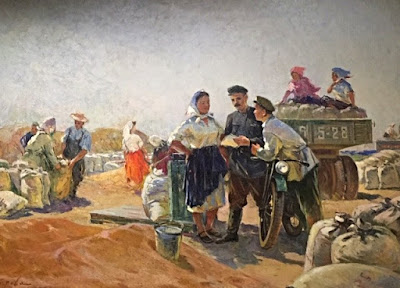A Lecture by Catalyst Executive Director Philip Gilpin
There's nothing like a good dose of reality to help sift out the serious dreamers from the halfhearted hopefuls in any field of endeavor. Whether artists or writers, inventors or entrepreneurs, you've no doubt seen a bit of that baloney known as Get Rich Quick and Be Famous. There seems to be an abundance of it on Medium right now. "How to start from scratch and get a six figure income in one year." Blahahahaha. (All you need to do is buy their book.)
All this to say, there really are careers in writing, art, invention and entrepreneurship. It involves understanding the rules of the game, a willingness to roll up your sleeves, and follow a plan.
The Catalyst Content Festival has made its new home here in Duluth with the serious aim of helping creatives understand the rules of the game. Wednesday evening was the first of a series of lectures designed to show the way.
 |
| Just before a screening at the Zinema, October 2019. |
As nearly everyone is well aware, the game has changed. Traditional television models of 22 minute and 48 minute shows with slots for commercials is being eclipsed by streaming content and episodic projects that stretch for years. How the new stories are being created is part of what Gilpin spoke about Tuesday evening in Mitchell Auditorium.
He began by stating that the process can be distilled to four steps. Pitch, Develop, Production and Post-Production. The total time from pitch to distribution is typically three years.
One of the most important lessons I gathered from Catalyst last fall was reiterated Tuesday. Television is a relationship-based business. It's not the same as selling a script to a studio and your done. Creatives and execs work together for years. Will you be easy to work with?
Agents
I have an agent joke that I will tell you some time if you ask. (Stop me if you've heard it.) It's about a screenwriter whose house has been destroyed in a fire.
Some people wonder what the purpose of an agent is. In part, it provides legal protection for networks, studios and buyers. I will give this example from the publishing industry.
At my first writers conference an exec from a publishing house told how they do not even open unsolicited game submissions any more. (This was 1983.) The reason being that in one year they received eight game concept submissions involving The Chronicles of Narnia. They already had a Chronicles of Narnia game in development and returned all eight. When their game was published, one of these eight sued, saying their idea was stolen.
It's gotta be a drag to have to deal with that stuff.
Agents are in communication with studios and producers, and know what is being sought. Therefore, they serve the function of vetting material before it is brought in for consideration.
Agents also fight on the artist's behalf to make sure they do not get bullied or taken advantage of. Most writers do not know what is the going rate for work that's been created or developed. Agents are not lawyers, though.
Gilpin noted that there are two kinds of agents: Lazy ones and Aggressive ones.
Legal Basics
 |
| Photo taken during Catalyst workshop in October. |
At some point in early in their careers writers wrestle with the matter of trust regarding their original ideas and creative work. I've known a few who will not hare what they have written for fear of it getting stolen.
Copyright laws in the U.S. are designed to protect creatives. As soon as you create it, it is copyrighted. Nevertheless, proving it in court is another thing. Therefore it is important to have a "chain of title" that shows the idea is yours to begin with. This keeps someone else from selling your script to the studio.
In this business, lawyers do most of the work, including copyrights and music clearances. According to Gilpin a lot of business is conducted without agents at all but through networking with industry friends.
Expectations
As in any endeavor it's important to set realistic expectations. Much has changed since the days when theaters and three networks ruled the world. The aim was to produce a show that would gain as wide an audience as possible.
Nowadays shows are being developed for very specific demographics and narrow niches. For this reason, ask yourself:
1) How specific is your show?
2) How original?
3) Who is your audience?
You can no longer say, "This show is for the 18-45 year old demographic. That's simply not going to cut it.
 |
| Photo: Cirina Catania |
Competition Among Giants
With streaming media and the crumbling of time constraints on programs, there's more variety than ever. And from the buyer's end of things a lot of competition due to the consolidation that has taken place.
AT&T / Time Warner / HBO are now one block.
Comcast / NBC and Disney / ABC / Fox are the competition.
Notice that there is no TV channel anymore that is separate from the broader universe of streaming media.
"These behemoths aren't sure what will work these days," Gilpin said.
It reminds me of the book publishing world of the Sixties. Until then every major publishing house had a religious books division. With the advent of the Jesus People movement and resurgence of grass roots Fundamentalism, the secular publishing houses produced a string of books that missed the target completely. As a result numerous Christian publishers rose up from within this Christian sub-culture to satisfy the unsatisfied hunger in this category.
What's going to work during the upcoming decade is an unknown, but my thinking here is that if you pay attention you may see areas where there are voids that need to be filled.
Gilpin pointed out that the mergers cited above have resulted in layoffs, with the result that studios are scared to sink big bucks into riskier projects. The need for new creative work is strong though. There were 500 new shows introduced last year. These shows take time to produce, and there are bottlenecks.
Bottleneck 1: There's a shortage of "showrunners." (Executive Producers)
Bottleneck 2: There's a finite number of locations where there's enough production talent to carry out the work.
Catalyst is hoping that Minnesota can become one of these locations.
Prospects
Is it difficult or just hopeless for newcomers to break in?
It's not hopeless, but it is difficult. The more you understand the process, the more likely you will achieve success. You have to decide where you fit. Some creatives write treatments and sell their ideas whereas others stay with a project all the way from start to finish. In either case the axiom holds true: Content Is King.
We can't predict the future, but storytelling is central to all.
Truly original concepts are a difficult gamble. And yet, they happen. Focus on good stories. Stories have captured our imaginations since the beginning of time.
Postscript
For an example of a Pitch Deck that became a major program, visit
http://www.zen134237.zen.co.uk/Stranger_Things/Stranger_Things_-_Bible.pdf




















































